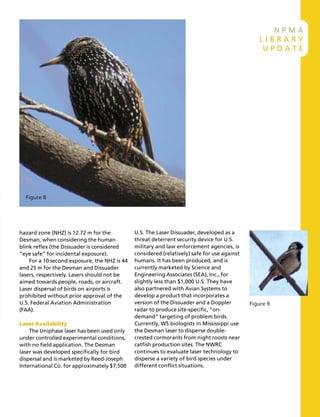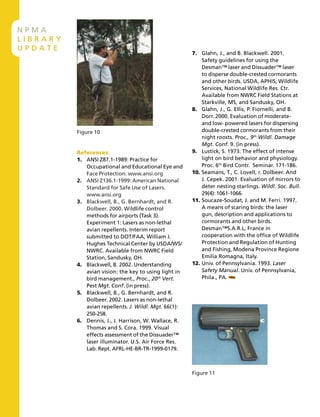Pest Management for Birds using Laser
- 1. J A N / F E B 2 0 0 3 Background Health, safety, and property damage associated with birds are often a source of concern. At the same time, the public (especially in the U.S.) wants non-lethal, non-injurious, and environmentally benign solutions to such problems. In situations where physical barriers, netting, and alarming agents or devices are not practical or are offensive to the local human population; there are currently few or no other non-lethal options for control of pest birds. Sight is well developed in most birds, including most common pest species. Several trials of directed or reflected light as a bird control tool have been reported4, 9, 10 . Recent research by the U.S. Department of Agricultureâs National Wildlife Research Center has shown that relatively low-power, long-wavelength lasers â 630-650 nm, producing a âredâ beam â can effectively disperse some pest bird species under low-light conditions, while presenting no threat to the birds or the environment. For example, double- crested cormorants and Canada geese (Fig 1.), have shown extreme avoidance of the reflected âspotâ at the end of such red laser beams. Other birds, including waterfowl, wading birds, gulls (Fig 3.), vultures (Fig 4.), and crows (Fig 5.), have also avoided red laser beam âspotsâ in field trials, but responses depended on the situation and species3, 5, 8 . The three main domestic pest bird species: Pigeons (Fig 7.), starlings (Fig 8.), and English sparrows (Fig 9.), are less readily repelled or dispersed by this technique. Pigeons and starlings can be forced out of roosting sites, but it may require numerous sessions (the period when a PMP disturbs the birds on their roost for a short period of time soon after dusk) repeated over several consecutive days. The lower power levels, directivity, accuracy over distance, and silence of laser devices make them relatively safe, effective species-specific alternatives to pyrotechnics, shotguns, loud recorded sounds and other traditional bird dispersal tools. Insert this update into the NPMA Pest Management Library, which can be purchased from the Resource Center. phone: 703-573-8330 fax: 703-573-4116 UpdateN P M A L I B R A R Y U P D A T E Using Lasers to Disperse Birds Figure 1 Figure 3 Figure 4 Figure 5
- 2. N P M A L I B R A R Y U P D A T E Avian Dispersal The use of lasers takes advantage of a major sensory pathway of birds (i.e., vision). The repellent or dispersal effect of a laser, targeting birds, is due to the intense, coherent, single wavelength of light, which can definitely cause changes in their behavior. These behaviors include moving away from the âspot;â becoming agitated, and, in some cases, physiological changes. Birdsâ responses are greatest under conditions of low light (dusk through dawn, or similar conditions) and when the reflected spot of a laser is directed onto structures or trees very near the roosting birds. Moving the spot around near the birds, especially toward them sometimes, usually increases their response. Some species of birds have been effectively caused to disperse by shining diffuse light (i.e., a q-beam) on and near them, but most birds quickly get used to it, and the effectiveness decreases quickly as distance from the light source increases. No habituation to the red lasers has been observed so far in repeated field trials6, 7 . Laser Classification and Safety The eyes of birds generally filter the most damaging radiation (e.g., short- wavelength radiation from the sun). In tests conducted with double-crested cormorants exposed to a relatively low- power Class-IIIb laser (see laser classification below) at a distance of one meter, no ocular damage was noted11 . Unlike birdsâ eyes, human eyes, except for the blink reflex, are essentially unprotected from thermal damage to retinal tissue which can be caused by concentrated laser radiation. Standards and guidelines have been established for laser classification and use, and for adequate protective devices and practices1, 2, 12 . Laser classification is determined by the amount of radiant power within a 7- mm aperture at a distance of 20 cm. Class I includes very low-power devices, which emit only a very small point of light. Class- II includes visible lasers that emit a radiant power of less than one milliWatt (<1 mW) as a low-power continuous wave (e.g., supermarket checkout scanners). Class IIIa includes most laser pointers used by speakers, which emit a weak beam (usually < 5 mW). Class-IIIb includes moderate-power lasers (5-500 mW; continuous wave) that are generally not capable of producing a hazardous diffuse reflection, except when someone intentionally stares at the source device very close to the diffuser (i.e., the laser head). Lasers tested by the NWRC include: the AC-powered, Class-IIIb, 10 mW, He-Ne, 633 nm High-Performance UniphaseâĒ laser; the Class-IIIb, 5 mW, He-Ne, 633 nm DesmanâĒ laser, model FL R 005 (Fig 10.); and the Class-II, battery-powered, 68 mW, 650 nm, diode Laser DissuaderâĒ (Fig 11.). Wildlife Services biologists currently use the Desman laser and Laser Dissuader in operational programs. Information on regulatory authority and safety specifications for laser use in bird management has been compiled in reference 7 (below), available from the NWRC library at: 970-266-6017. Safe and successful bird dispersal by lasers in a variety of settings depends on individual site conditions, particularly in urban areas. Specific, current requirements for laser operations and PPE in the U.S. is available on the OSHA website: www.osha.gov (also, see references 1 and 2, below). Any laser operator must consider background, range of the beam, and potential reflections. The nominal Figure 7
- 3. hazard zone (NHZ) is 12.72 m for the Desman, when considering the human blink reflex (the Dissuader is considered âeye safeâ for incidental exposure). For a 10 second exposure, the NHZ is 44 and 25 m for the Desman and Dissuader lasers, respectively. Lasers should not be aimed towards people, roads, or aircraft. Laser dispersal of birds on airports is prohibited without prior approval of the U.S. Federal Aviation Administration (FAA). Laser Availability The Uniphase laser has been used only under controlled experimental conditions, with no field application. The Desman laser was developed specifically for bird dispersal and is marketed by Reed-Joseph International Co. for approximately $7,500 N P M A L I B R A R Y U P D A T E U.S. The Laser Dissuader, developed as a threat deterrent security device for U.S. military and law enforcement agencies, is considered (relatively) safe for use against humans. It has been produced, and is currently marketed by Science and Engineering Associates (SEA), Inc., for slightly less than $1,000 U.S. They have also partnered with Avian Systems to develop a product that incorporates a version of the Dissuader and a Doppler radar to produce site-specific, âon- demandâ targeting of problem birds. Currently, WS biologists in Mississippi use the Desman laser to disperse double- crested cormorants from night roosts near catfish production sites. The NWRC continues to evaluate laser technology to disperse a variety of bird species under different conflict situations. Figure 8 Figure 9
- 4. N P M A L I B R A R Y U P D A T E References: 1. ANSI Z87.1-1989: Practice for Occupational and Educational Eye and Face Protection. www.ansi.org 2. ANSI Z136.1-1999: American National Standard for Safe Use of Lasers. www.ansi.org 3. Blackwell, B., G. Bernhardt, and R. Dolbeer. 2000. Wildlife control methods for airports (Task 3). Experiment 1: Lasers as non-lethal avian repellents. Interim report submitted to DOT/FAA, William J. Hughes Technical Center by USDA/WS/ NWRC. Available from NWRC Field Station, Sandusky, OH. 4. Blackwell, B. 2002. Understanding avian vision: the key to using light in bird management., Proc., 20th Vert. Pest Mgt. Conf. (in press). 5. Blackwell, B., G. Bernhardt, and R. Dolbeer. 2002. Lasers as non-lethal avian repellents. J. Wildl. Mgt. 66(1): 250-258. 6. Dennis, J., J. Harrison, W. Wallace, R. Thomas and S. Cora. 1999. Visual effects assessment of the DissuaderâĒ laser illuminator. U.S. Air Force Res. Lab. Rept. AFRL-HE-BR-TR-1999-0179. 7. Glahn, J., and B. Blackwell. 2001. Safety guidelines for using the DesmanâĒ laser and DissuaderâĒ laser to disperse double-crested cormorants and other birds. USDA, APHIS, Wildlife Services, National Wildlife Res. Ctr. Available from NWRC Field Stations at Starkville, MS, and Sandusky, OH. 8. Glahn, J., G. Ellis, P. Fiornelli, and B. Dorr. 2000. Evaluation of moderate- and low- powered lasers for dispersing double-crested cormorants from their night roosts. Proc., 9th Wildl. Damage Mgt. Conf. 9. (in press). 9. Lustick, S. 1973. The effect of intense light on bird behavior and physiology. Proc. 6th Bird Contr. Seminar. 171-186. 10. Seamans, T., C. Lovell, r. Dolbeer. And J. Cepek. 2001. Evaluation of mirrors to deter nesting starlings. Wildl. Soc. Bull. 29(4): 1061-1066. 11. Soucaze-Soudat, J. and M. Ferri. 1997. A means of scaring birds: the laser gun, description and applications to cormorants and other birds. DesmanâĒS.A.R.L, France in cooperation with the office of Wildlife Protection and Regulation of Hunting and Fishing, Modena Province Regione Emilia Romagna, Italy. 12. Univ. of Pennsylvania. 1993. Laser Safety Manual. Univ. of Pennsylvania, Phila., PA. Figure 10 Figure 11




